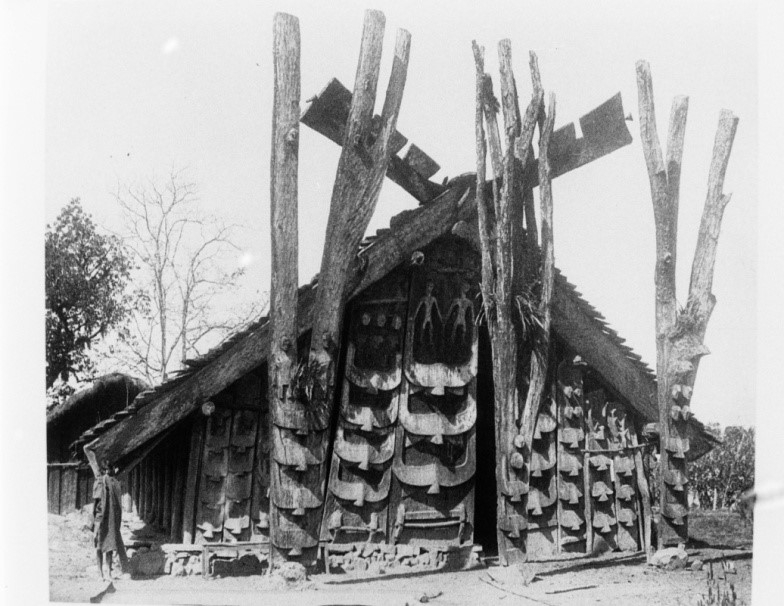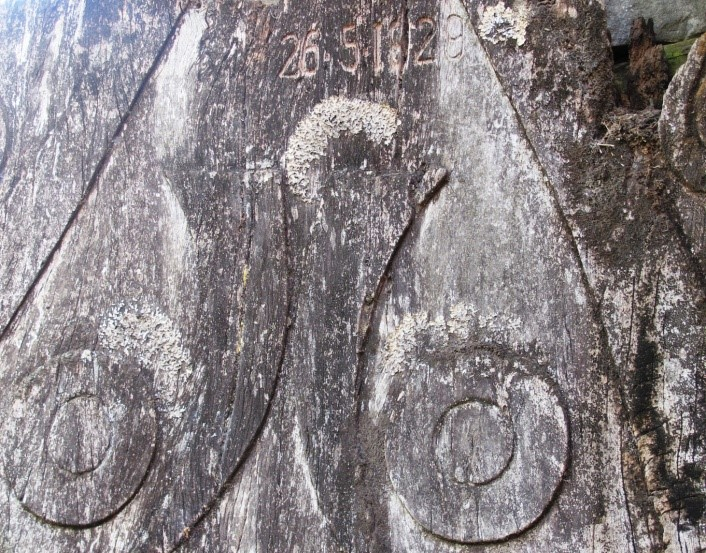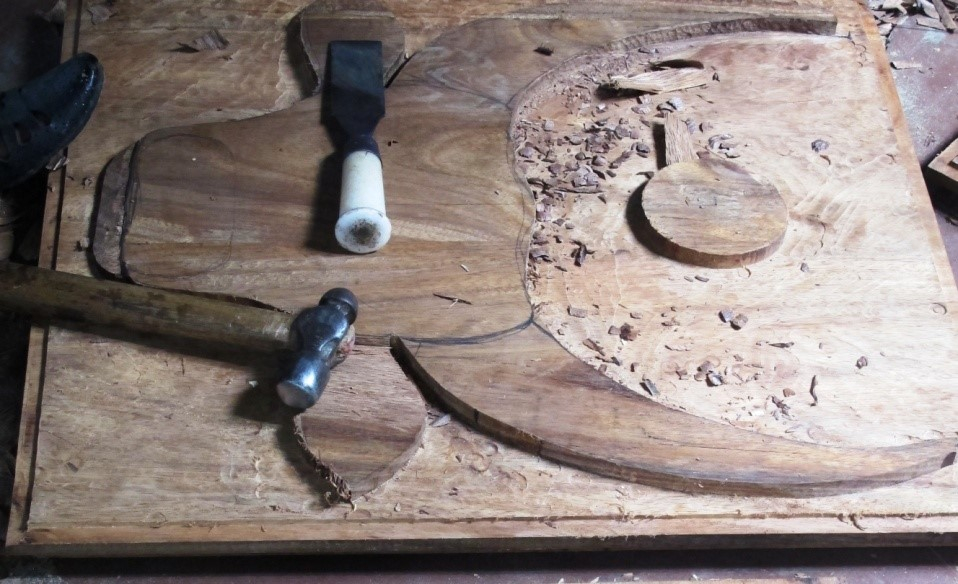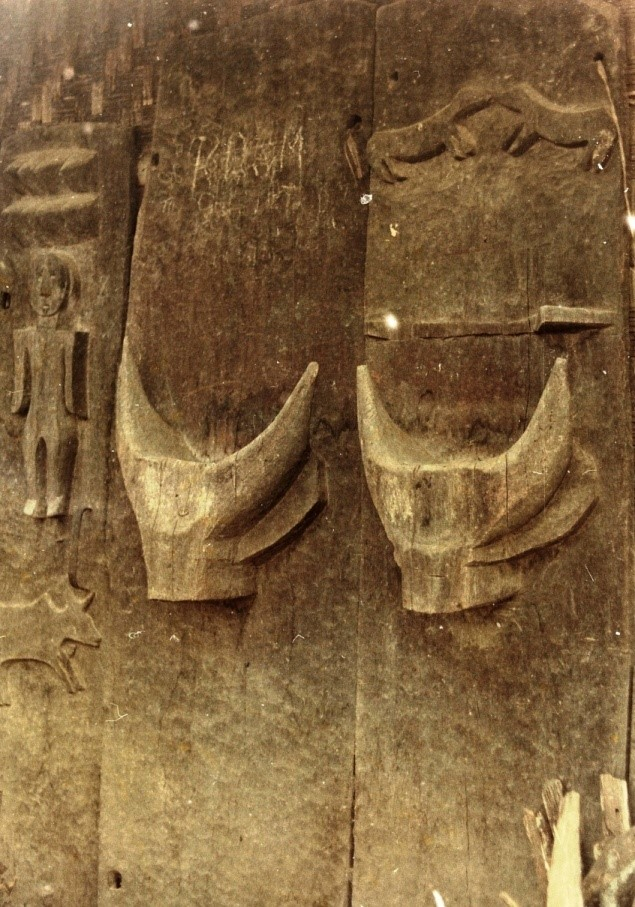
In Nagaland, woodcarving as an art form relates largely to architecture and ritual practice and has been the forte of most of the 17 major Naga tribes in both eastern and western parts of the state. Wood craft is traditionally practised only by male members of the community and continues as such even today. However, the Naga, Konyak, Phom and Angami communities are especially noted for their amazing woodcarving skills. All the other tribes have similar skills, but are distinguished by signature styles with marked differences in the usage and portrayal of designs and symbols. In the past every male member of the community had some sort of basic woodworking skills; nowadays, the skill is confined to specialist master artisans who have made it a livelihood or profession. Motifs of bison or mithun and human heads are common to all tribes, but degrees of use vary.
Nagaland as a whole, is vibrant with a rich architectural wood craft tradition which has its roots in an animistic past: a lost culture of magnificent huge wood-carved building façades and village gates with the mithun or Indian bison horns and head dominating all else with their immense visual appeal. The mithun head and house horns were the most powerful wood-carved elements, especially among the Angami and Chakhesang and to a lesser extent, the Ao and Sumi (Sema) tribes. However, among the Eastern Nagas like the Konyak and Chang, woodcarving lent itself more to human figurines and heads as fertility symbols and hornbill motifs which had a special significance in the social hierarchy of the time. The hornbill was the elite symbol of the Ang or village chief, who enjoyed a divine status in the Konyak tribe who inhabit Mon district lying at the northern tip of the state.

A lot of animal motifs like those of tiger, elephant, monkey and snake were depicted besides the inevitable mithun and the hornbill. Each animal was symbolic of a particular quality or character that was highly regarded in those times, like courage, strength, fighting prowess. Besides these, there were many other woodcarved motifs that found place on the totem-like front posts, or walls of chiefs' houses or men’s dormitories called the morungs. There were breasts that spoke of love conquests amongst the Sema chiefs, meat chunks that represented feasts of merit given by the house owner, and sun, star and moon representations as natural spiritual elements, and daos (multipurpose machete) and spears praising the warrior status and prowess of the morung members. The men’s dormitories (morungs) had the most elaborate and impressive of wood carvings and distinct architectural styles and were positioned in special sites in the settlement.

Door and gate wood carvings deserve their own category in the wide domain of Naga wood craft. They are not only magnificent in style and treatment but have an awe-inspiring girth and scale which is unmatched in the rest of India. Beautifully styled and often coloured in black, terracotta and white pigments derived from natural sources, they proclaimed the status and power of the house owner or the village itself.
Besides architecture, wood craft finds a place in the daily life of the Nagas, where it is a huge part of the traditional kitchen and tableware as well as furniture. In the vast array of tableware, the most commonly found objects fashioned wholly out of wood are beer mugs, bottles for the traditional rice beer, cooking and serving spoons, ladles, plates and platters, troughs, barrels, and numerous other items of daily use. Salt and containers with bamboo-shoot lids for dried food were smoked and kept above the fireplace and often embellished with cane binding or straps. Low stools, tables and beds were fashioned out of massive pieces of solid wood, and were literally scooped out of the wood chunk without jointing of any kind. This crafting style characterises all of Naga wood craft, which is basically sculpted out of solid trunks or pieces of wood.

Earlier, before the forests lost their thick cover of tropical green, wood was easily available and accessible to all. At times, the wood used for furniture and in architecture was the huge hollock or hollong tree trunk and at times teak. Leikai is another commonly used tree for carving houses. However, now teak is the naturally preferred wood for craft. In smaller craft items, gamari soft wood is used more frequently due to the ease of carving on it, and also due to its ready availability on plantations. The dao or machete, hammer and chisel were the only tools used in woodcarving in the past and continue to be the major tools today. The first step of the traditional woodcarving technique is to trace the drawing onto the wood with a pencil. Thereafter the chisel is hammered at a practised angle to scoop out chips in relief, as per the design. It is basically a sculpting action that creates the relief work on a flat thick plank. For sculpted columns, an entire tree trunk was used in its natural form and simply patterned with carving on its surface area all around. However new hand and machine tools and techniques have crept in and made a place for a more sophisticated version of wood craft, and hence are able to attract more youth towards this version of the traditional craft.
Naga woodcarving is massive in form and scale yet graphic in its representations. It’s stark unique beauty is square and crude-edged with a geometric sensibility, with surface texturing being the most common decorative treatment. As a whole there is an undefined style that has its own identity. Over a thousand different mithun-head designs are rendered across the state and its various tribes, each more beautiful than the next and equally endearing. Stories of the past are scripted in the wood carvings of yesteryears, of war exploits, feasts and myth. They speak of a generation that understood the land and forest and had a simple pride in their civilization.

In most parts of Nagaland, with the exception of a few interior areas of the eastern Nagas, a lot of the old architectural wood carvings have disappeared as many villages were burnt down during the British era. In later years during the height of insurgency in the '50s, the Indian army contributed to the destruction, when they conducted flushing-out operations and resorted to the same violent modus operandi as the British. With changes in the social context and technology, the craft has developed an economic avatar which pays lip service to traditional motifs but is obviously completely disconnected from its past form and meaning. There is a revival of sorts in some recent architecture which seeks to mimic the symbolism without its context. It even changes material at times, as the woodcarving style is translated into concrete and stone expressions. As the new context looks for new expressions and new ways in wood craft, design elements are being introduced in the craft to preserve its spirit and revive and renovate this age-old skill. What now remains as mute testimony of the past is only a tiny glimpse into a once magnificent tradition, that struggles for survival in a new world and milieu. Bits and pieces of a lost world.
